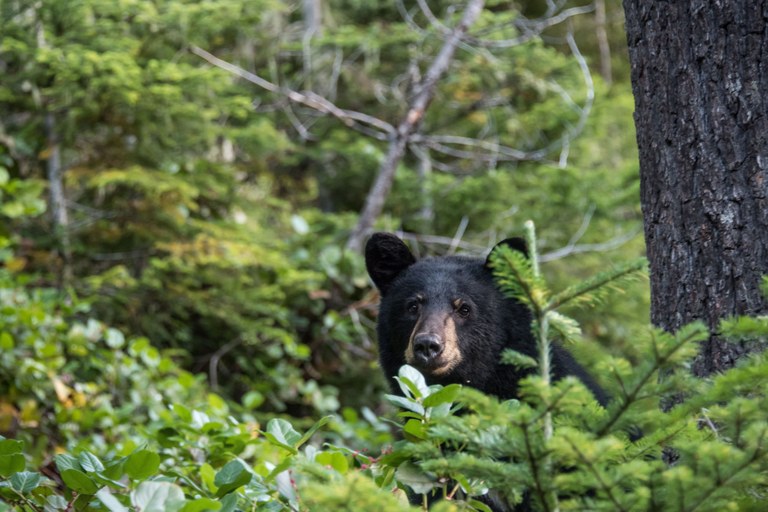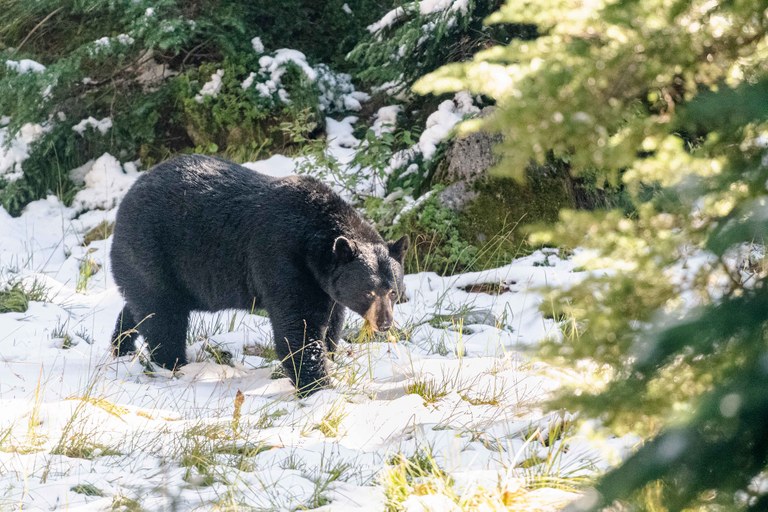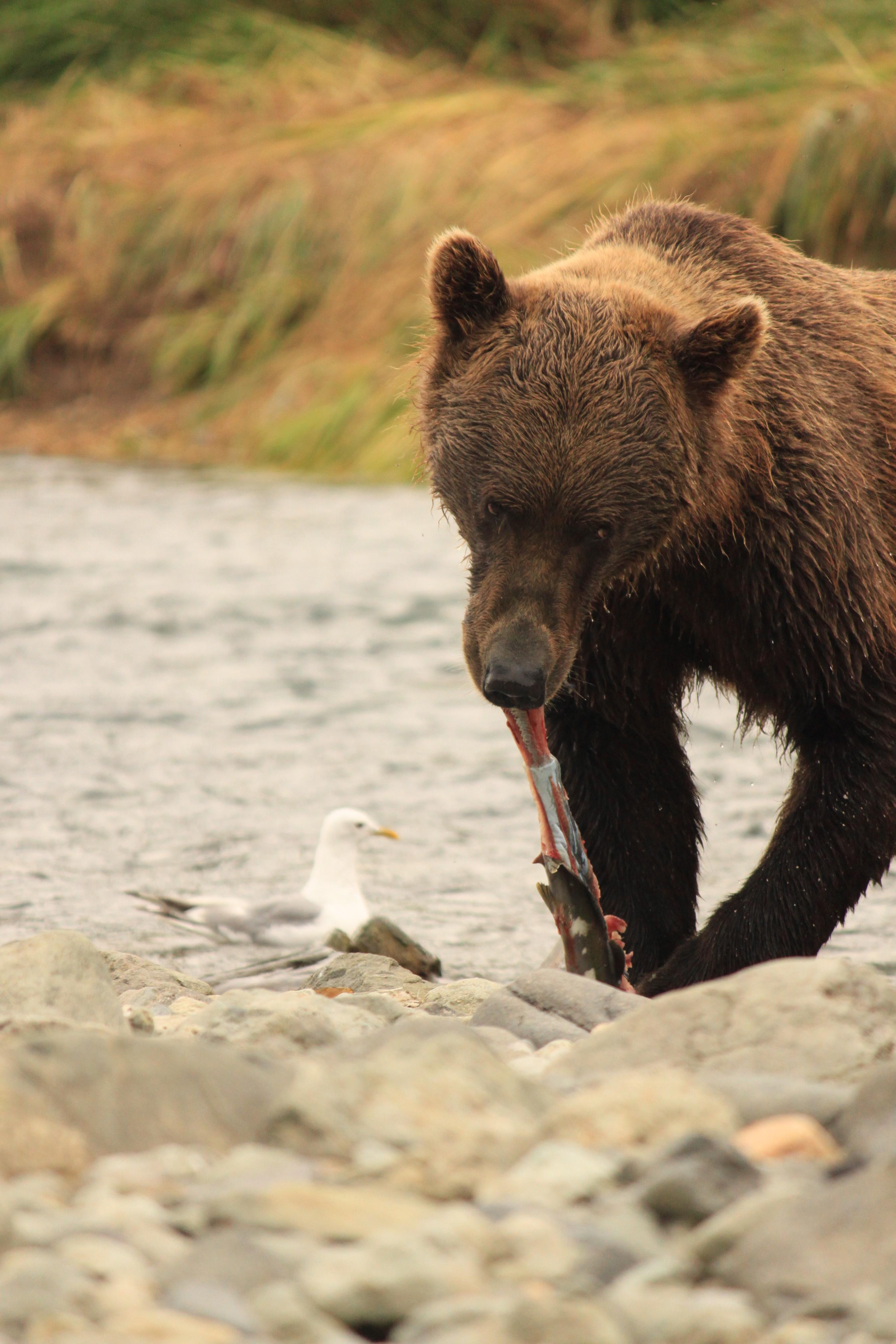How to Hike in Bear Country
Seeing a bear while hiking can be an incredible thrill, but there are some key things to know about bears when you hike, camp, or live in bear country.
Most bears in Washington are black bears, but there is a tiny population along the border with Canada, predominantly in the northeast corner of the state, and a small number of grizzlies are going to be reintroduced to the North Cascades.
While the odds of seeing a black bear or a grizzly are low, practicing safe food storage and responsible recreation go a long way to lowering your odds of attracting or encountering a bear.
 A black bear checking in on hikers along the Comet Falls Trail. Photo by Thomas Bancroft.
A black bear checking in on hikers along the Comet Falls Trail. Photo by Thomas Bancroft.
Identifying black bears or grizzly bears
If you see a bear in Washington, it's almost certainly a black bear, but here are things to look for to determine which kind of bear you're looking at.
- Grizzlies (brown bears) are larger than black bears
- Grizzlies have a more prominent hump on their shoulders and less prominent ears.
- Black bears aren't always black. They can have a cinnamon or brownish coat.
 Black bears at Mount Rainer often take on a cinnamon color. These year-old cubs are busy feasting on berries with their mama to prepare for the long winter ahead. Photo by Peter James.
Black bears at Mount Rainer often take on a cinnamon color. These year-old cubs are busy feasting on berries with their mama to prepare for the long winter ahead. Photo by Peter James.
What bears eat
- Black bears are omnivores, and eat mostly plants and bugs, with a small amount of meat from fish, mice, voles, squirrels, eggs and the rare fawn or elk calf.
- According to the Washington Department of Fish and Wildlife, the spring diet of a black bear consists mostly of herbaceous plants, from emerging grasses and sedges to horsetail and various flowering plants.
- While grizzlies are more carnivorous than black bears, scientists expect grizzlies in Washington to have a 90% plant-based diet.
- In summer, bears typically add ants, bees, grubs and a host of later emerging plants to their diets. During late summer and fall, bears typically shift their diets toward tree fruits, berries and nuts, but they still may consume a variety of plants.
- In fall, they may forage up to 20 hours a day to increase their body weight by 35 percent in preparation for winter.

A hungry black bear snoops around Pelton Basin for food as winter nears. Photo by Hector Marquez Garcia.
Hiking near bears
- Make noise by singing or clapping your hands while in bear country, and especially around streams and blind corners. (The goal of making noise is to avoid surprise encounters.)
- As you hike, stay aware of your surroundings, so you don't stumble into an encounter. That means not listening to music, and keeping your head up, looking around as you hike.
- Hike in small groups during daylight hours. Avoid traveling at night, dawn, or dusk.
- Watch for bear sign, such as tracks (footprints), piles of scat full of berries and small trees scratched to bits by hungry bears looking for grubs.
- Keep small children close and on trail.
- Always keep a safe distance from wildlife. Never intentionally get close to a bear.
- Keep dogs on leash.
- Are you planning to make your hike an overnight or multi-night backpack? Keep a clean camp. Learn how to bear-proof your camp and hang a bear bag.
- You can also carry bear spray into areas where bear encounters are more likely. Know how to use this and store it safely.
Bear encounters
Although aggressive behavior is very rare, a bear will defend its young or food source if it feels threatened. Startling a bear can also lead to distress and agitation. Most times bears prefer to avoid confrontation and will flee, but when they are agitated, you’ll be able to read the signals clearly. First and foremost - do not run away if you see a bear. You cannot outrun a bear.

Black bears will usually flee or run away from you. Photo by Jeff Lewis.
They wear their emotions on their big, furry sleeves, and you’ll see signs of distress such as jaw popping (opening their mouth and snapping it shut) as well as head turning, huffing or vocalizing, or aggressively slamming their paws to the ground. If a bear behaves this way, it’s trying to tell you that you’ve crossed the line. In this case:
- Do not look the bear in the eye. This is perceived as a challenge and a sign of dominance.
- Never turn your back to a bear. If safe to do so, slowly walk backwards and give the bear as much space as possible.
- If you are hiking with small children, pick them up (so they do not run, scream or panic).
- Talk calmly and quietly so the bear can identify you as a human.
Occasionally a bear will bluff charge as its way of trying to resolve the situation on its own. This is when a bear charges, then stops short of you and veers off, running away. This is highly unlikely to happen if you have followed proper etiquette around bears, but if it does, your body language in this situation could save your life.
Stand your ground and hold as still as possible without making eye contact. Don’t even take half a step backwards.
If you do encounter a bear who has acted aggressively toward you, it's important to stop by (or at least call) a ranger station and let them know.
Keep dogs on leash to prevent conflicts
While bears are shy of people, they may act differently towards dogs, especially if they have cubs nearby. The biggest conflict a hiker could expect to get into with bears would be having a dog attacked.
- The best prevention for any conflicts is keeping your dog close and on leash while you hike. WTA has heard from a hiker who had an off-leash dog injured by a bear. If you have your dog leashed, you will be more able to control the situation.
- If you're backpacking with a dog, make sure your pup stays inside your tent with you.
Living near bears
- Take trash out the morning of garbage day, instead of the night before.
- Avoid using bird feeders, except in winter.
- Clean outdoor grills after each use, including any grease drippings.

Bears play an important role in the ecosystem. This grizzly bear photo was taken in Alaska. Photo by Gabriel Davis

